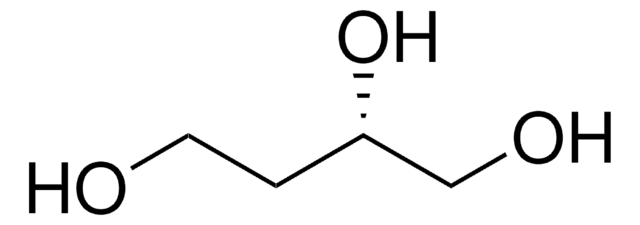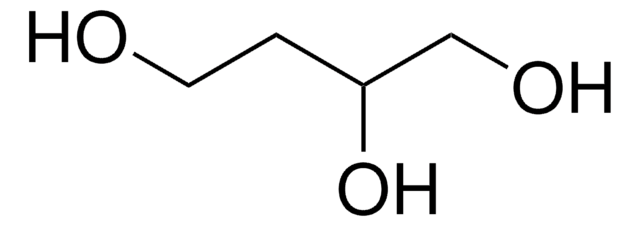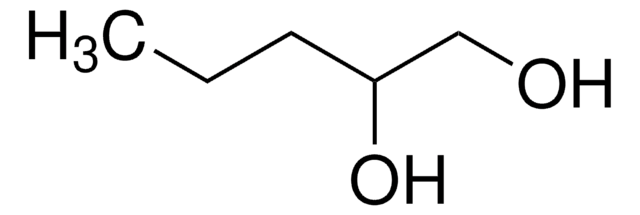8.07061
1,5-Pentanediol
for synthesis
Sinónimos:
1,5-Pentanediol, Pentamethylene glycol
About This Item
Productos recomendados
presión de vapor
>0.01 hPa ( 20 °C)
Nivel de calidad
Análisis
≥97.0% (GC)
formulario
liquid
temp. de autoignición
330 °C
potencia
10000 mg/kg LD50, oral (Rat)
>19800 mg/kg LD50, skin (Rabbit)
lim. expl.
1.3-13.1 % (v/v)
pH
7.5 ( in H2O)
bp
240-242 °C/1013 hPa
mp
-16 °C
temperatura de transición
flash point 136 °C
densidad
0.99 g/cm3 at 20 °C
temp. de almacenamiento
2-30°C
InChI
1S/C5H12O2/c6-4-2-1-3-5-7/h6-7H,1-5H2
Clave InChI
ALQSHHUCVQOPAS-UHFFFAOYSA-N
Aplicación
- Biodegradable Polymers for Sustainable Packaging: A study on biobased multiblock copolymers incorporating 1,5-Pentanediol for sustainable food packaging explores the use of poly(l-lactic acid) and 2,5-furandicarboxylic acid, offering insights into composting kinetics and mechanisms (Bianchi et al., 2023).
- High-Temperature Battery Applications: Research on working aqueous Zn metal batteries at 100°C examined the role of 1,5-Pentanediol in stabilizing electrolyte solutions, highlighting its utility in high-performance energy storage systems (Wang et al., 2022).
- Biopolymer Synthesis for Environmental Sustainability: Engineered Halomonas bluephagenesis synthesizes diverse α,ψ-diol-derived polyhydroxyalkanoates, utilizing 1,5-Pentanediol, to create plastics with improved biodegradability and performance in environmental applications (Yan et al., 2022).
- Advanced Materials with Barrier Properties: A study on renewable furfural-based polyesters containing 1,5-Pentanediol reports high oxygen barrier properties, suitable for packaging applications that require extended shelf life and sustainability (Ahmed et al., 2022).
Nota de análisis
Density (d 20 °C/ 4 °C): 0.988 - 0.991
Identity (IR): passes test
Código de clase de almacenamiento
10 - Combustible liquids
Clase de riesgo para el agua (WGK)
WGK 1
Punto de inflamabilidad (°F)
287.6 °F - closed cup
Punto de inflamabilidad (°C)
142 °C - closed cup
Certificados de análisis (COA)
Busque Certificados de análisis (COA) introduciendo el número de lote del producto. Los números de lote se encuentran en la etiqueta del producto después de las palabras «Lot» o «Batch»
¿Ya tiene este producto?
Encuentre la documentación para los productos que ha comprado recientemente en la Biblioteca de documentos.
Los clientes también vieron
Nuestro equipo de científicos tiene experiencia en todas las áreas de investigación: Ciencias de la vida, Ciencia de los materiales, Síntesis química, Cromatografía, Analítica y muchas otras.
Póngase en contacto con el Servicio técnico








